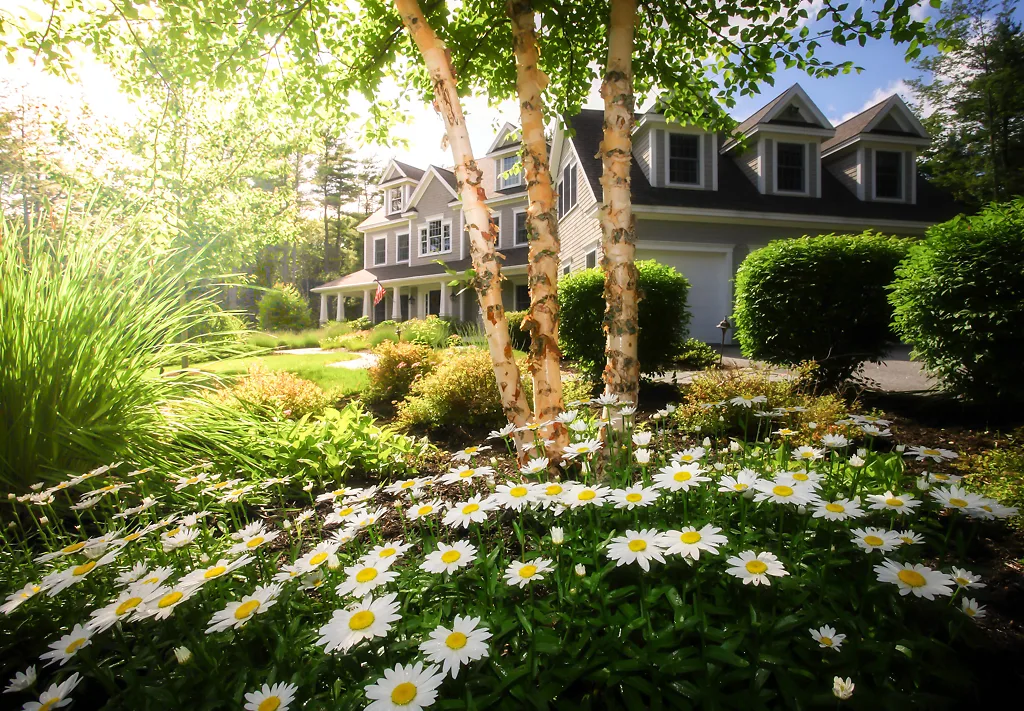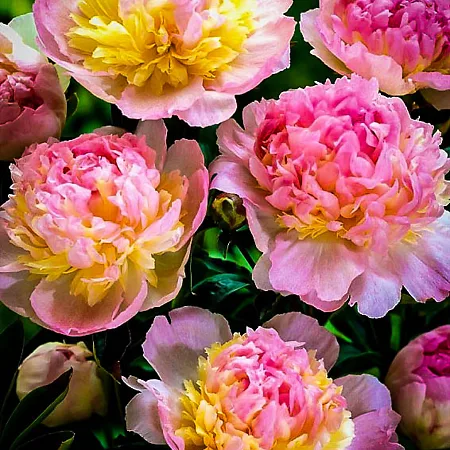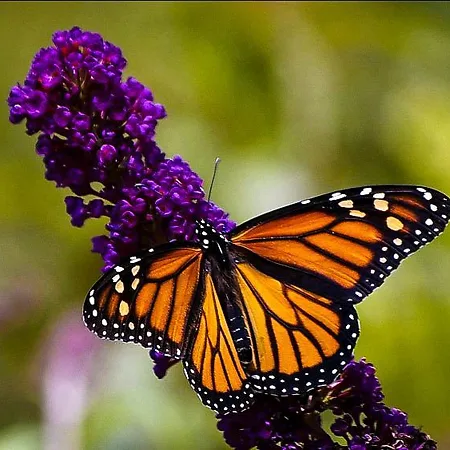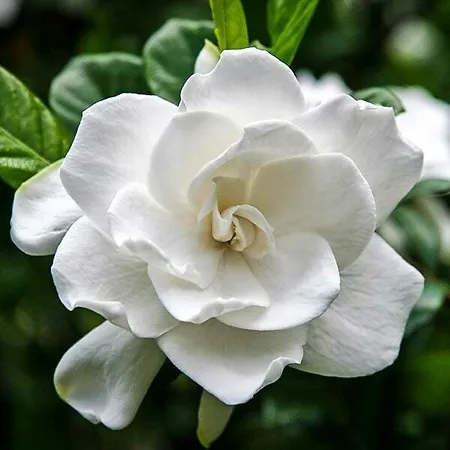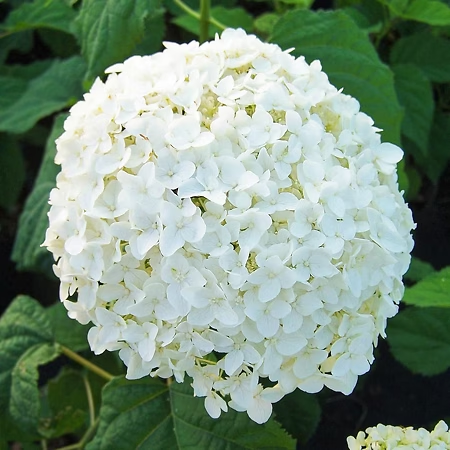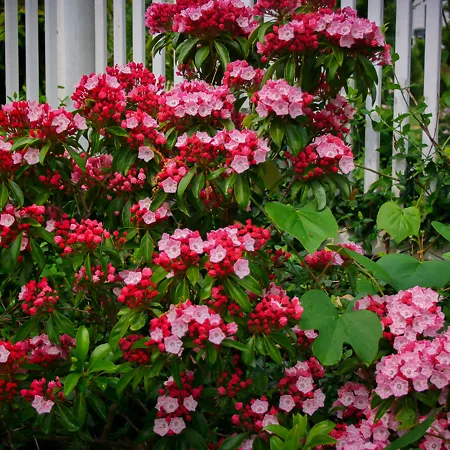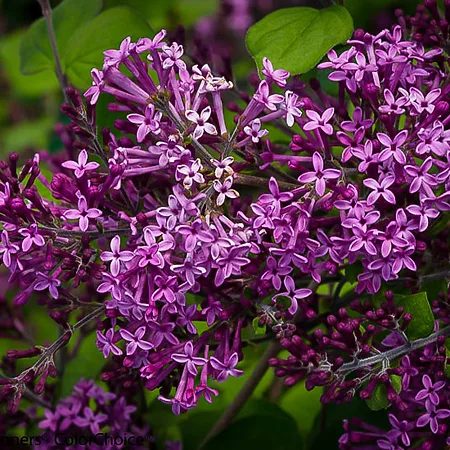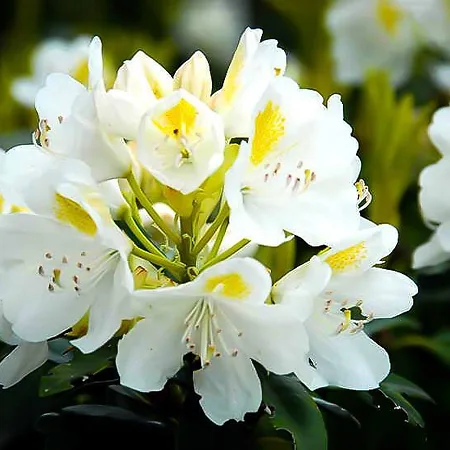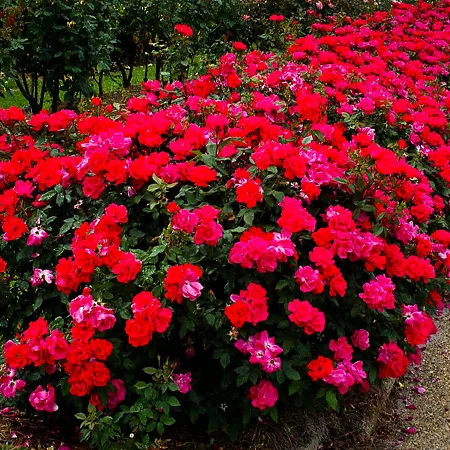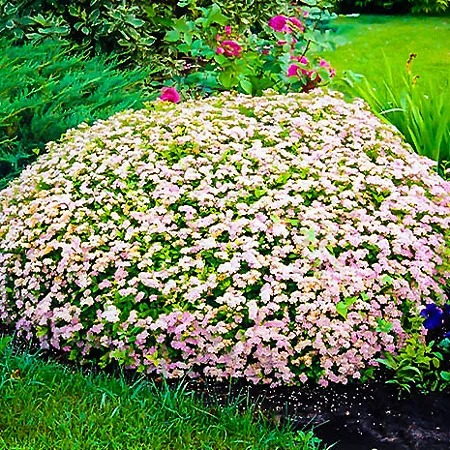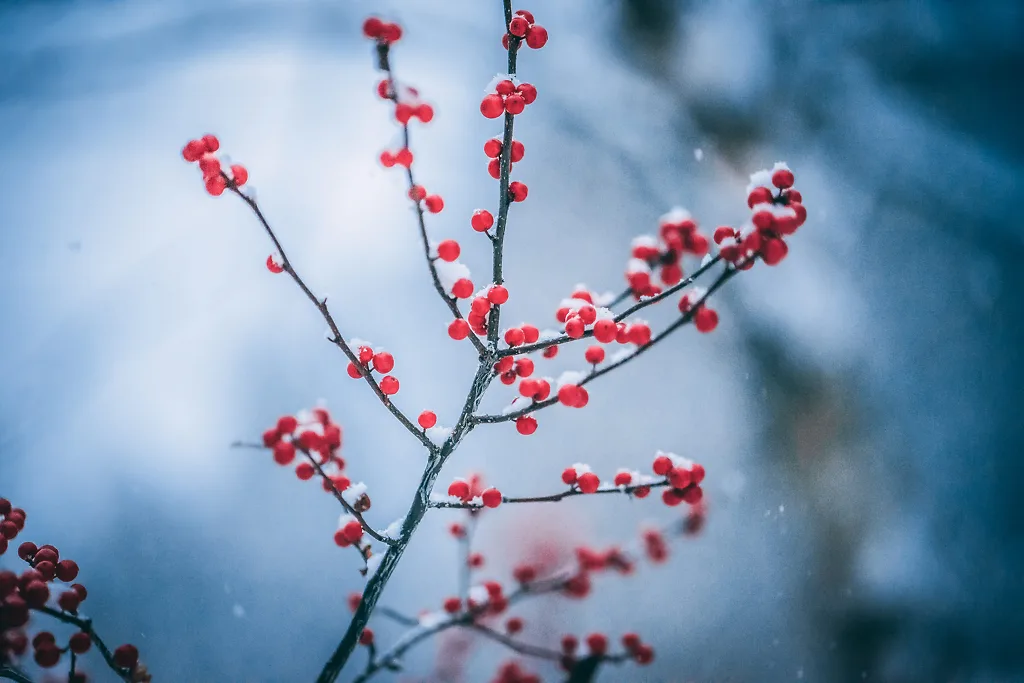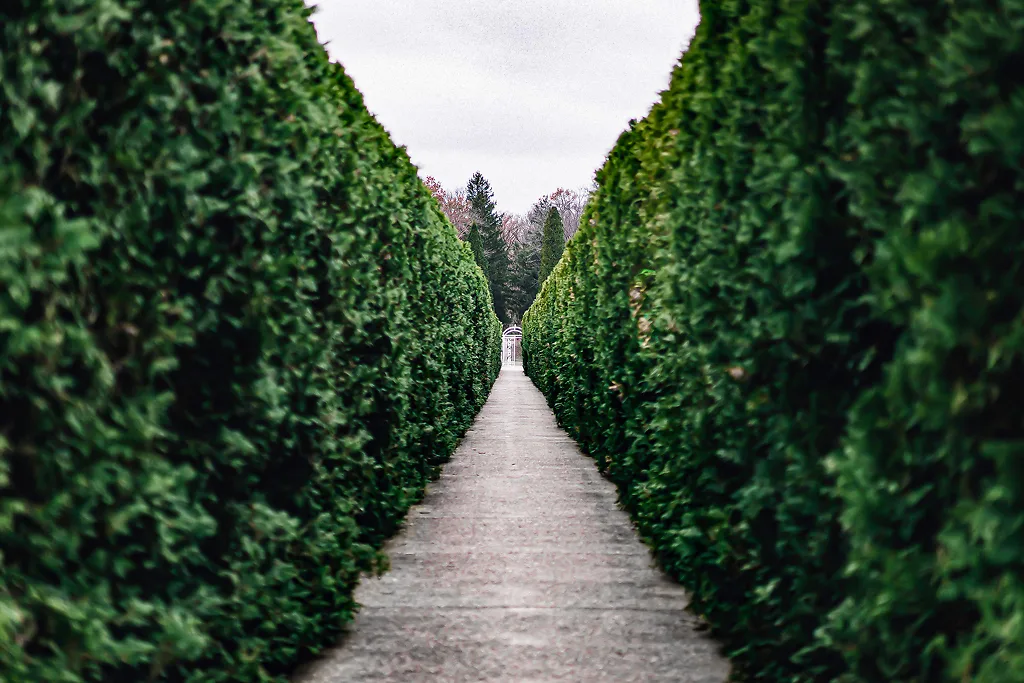Flowering Shrubs
You can make a garden without using any flowers. This is perhaps true, but for almost everyone a garden without flowers is like French fries without salt -edible enough, but not much fun. Shrubs that bring colorful blossoms are the icing on the garden cake, the thing that lifts our hearts in spring especially, and that give us infinite pleasure just from seeing them. For more serious gardeners, growing as wide a range as possible can be a lifetime pursuit, and there always seems to be room for one more in the garden, right?
If you have a lot of time available you can grow flowers and perennials for blooms, but Flowering Shrubs give us the best reward for our time, and if you choose wisely you can have blooms for month after month, on plants that need almost no care. Once you have built the foundations of your garden with our Foundation Plants, it is time to fill in that framework with form and color. Our Colorful Shrubs do that with foliage, and give months of color, but for true glory in the garden, nothing beats Flowering Shrubs.
Using Flowering Shrubs in Your Garden
The best Flowering Shrubs have two roles to play in your garden. Their foliage and branches give form and structure, filling the spaces of your yard with a variety of shapes and sizes, with varied leaf shapes, and forms from upright to rounded and weeping too. The flowers are almost a bonus, and they bring a big lift when the appear. The ideal shrub has a long bloom period, and with many plants like roses and azaleas, breeders have worked hard to give us those longer bloom periods, and repeat-blooming in fall, after a spring display.
We all have moments of weakness, when we see a plant and say, “I have to have that!” It is fine to give in to such impulses, and then try to find a place in your garden to grow it, when something grabs your heart. You will see, however, that professional garden designers come at it the other way round. They start with the shapes, colors, seasons and effects they want, and then find plants to fill those requirements. This is a better approach and will yield a better garden that still has room for favorites and impulse buys.
Planting for Succession -the key to success with Flowering Shrubs is to plan so that something is always in bloom through the seasons. Most shrubs only bloom for two or three weeks of the year (always worth waiting for, though) so you need to have plants that start at different times. Sometimes you can achieve this within a single plant group. Camellias, for example, can be in bloom from fall to early summer, and all through winter, if you choose the right varieties. Spring has so many shrubs in bloom that it is easy to end up with that being the only colorful season in your yard. To prevent that happening, be sure to include summer-blooming Spirea, Butterfly Bush (Buddleja), Hydrangeas, Crape Myrtle and other late-bloomers in your planting plans. That way there is always something to enjoy in flower.
Go for Multiple Points of Interest -especially in smaller gardens it is good to choose flowering shrubs with other points of interest besides flowers. Some have colored leaves in spring or all summer, and others can have beautiful fall colors. Plants like the Ever Red® Loropetalum have gorgeous blooms and vibrant foliage too, while Crape Myrtle, Viburnums and some of the Redbuds, have wonderful fall colors. Don’t forget fruit either, with Viburnums again standing out for that, as well as some Landscape Roses, with beautiful red rose-hips in fall. With Hydrangeas it can be the flowers themselves that bring fall color, especially in the Panicle and Oak-leaf varieties, where the fading flowers are colorful and beautiful.
Flowering Shrubs of one sort or another can be used in all parts of the garden, in many roles:
Hedges -why stick to a plain-green hedge, when you can have blooms? You might not be able to trim as frequently or as tightly, but good hedges can be made with many Flowering Shrubs. Camellias are surprisingly fast-growing, and if they are trimmed only once a year, just after flowering, they can be made into beautiful hedges. Look for varieties that are upright, with a neat form, and once that can grow to the size you want. Roses, especially the ever-blooming kinds, like Knockout roses, or the Oso Easy Landscape roses, make beautiful flowering hedges for internal garden divisions.
Edging -smaller flowering shrubs, like Little Princess Spirea, make spectacular edging for larger beds, and any smaller Flowering Shrub can be used for this purpose. In shady areas there are some great small Hydrangeas that are perfect for edging, or in warmer areas Gardenias are not only beautiful edging, but they fill the air with perfume as you walk by them. Encore Azaleas are also perfect edging, especially for months of color. The Drift Roses are profuse bloomers over months, and they stay low and spill out across a path or terrace.
Foundation Planting -although we normally focus on evergreens for foundation planting, with good green foliage, you can have that, and enjoy flowers too. Evergreens like Camellias, Azaleas and Rhododendrons are perfect, or in colder areas the neat forms of some smaller Lilacs, such as the Fairy Tale® Lilacs, with names like Thumbelina or Prince Charming, bring flowers in their season, and great foliage for the rest of the summer. Varieties of the Korean lilac like these are always compact and rounded, with smaller leaves, but just as hardy as the larger French lilacs.
Garden Beds -growing in garden beds is the natural place to find flowering shrubs, and there you can grow them in profusion. Plant them as single specimens in smaller beds, or in groups of 3, 5, 7 or more in larger ones. For groups, plant them between one-half and two-thirds of their mature diameter apart to get a continuous flow and avoid ‘blobs’. Try to spread out foliage contrast and blooming season as well as size when you are organizing your beds. If you have a larger garden, making seasonal beds, instead of spreading the seasons around, will give you more spectacular effects, and gives beds with massive impact at key times of year.
Lawn Specimens -although we think of shade trees on lawns, in smaller gardens there is rarely room for more than one, or no room at all for a large tree. In that case, larger flowering shrubs like Lilacs or Panicle Hydrangeas make terrific specimens on a lawn, where they can be admired in all their beauty.
Woodland Gardens -Many flowering shrubs, such as Rhododendrons, Azaleas and Camellias, are ideal for semi-shaded areas, such as beneath trees. Any shade-tolerant shrub can be grown in a natural way in a wooded area. Always prepare good planting holes so that they can establish before they have to compete with tree roots, and extra summer watering may be needed. Add flowering trees like Dogwoods, and you have a glorious natural garden to enjoy.
Planters and Pots -Smaller shrubs are perfect for planter boxes or tubs. Why limit your balcony or terrace gardening to annual flowers, when you can create a colorful environment with Flowering Shrubs? Avoid all that seasonal re-planting and expense and remember that these shrubs will get better and better as they grow. Add some evergreens for winter interest and you are all set. Growing in pots is also a good way to grow acid-loving shrubs, like Camellias and azaleas, if you don’t have acid soil in your garden. Use potting soil for acid-loving plants, and fertilizer regularly, and you will be amazed at the results.
The Appearance of Flowering Shrubs
Flowering Shrubs cover all sizes of plants, from those a foot or so tall, up to big plants around 15 feet or more. The main distinction between a ‘tree’ and a ‘shrub’ is not so much size as the number of trunks. One, two or three trunks, and we call it a tree. Multiple stems and it will be a shrub, even if it is large.
Evergreen Flowering Shrubs
Some Flowering Shrubs are evergreen, usually called ‘broad-leaf evergreens’ to avoid confusion with those other evergreens, the conifers, like spruce or pine. Most evergreen shrubs do best in warmer zones, and they give a year-round continuity in the garden. If you can grow them in your zone it is a good idea to try and have at least half your shrubs and trees evergreen, so your garden has good winter structure.
Deciduous Flowering Shrubs
Usually faster-growing than evergreen shrubs, those that lose their leaves in winter can be smothered in blooms when they come back to life in the spring. Most are easy to grow and hardy, so plants lots of them around your garden, alone or in groups. They are especially useful in colder states, where evergreen shrubs won’t grow. Learning how to prune them is helpful in getting the best result and the longest life from many of them.
Repeat-blooming Flowering Shrubs
Most Flowering Shrubs flower once a year, for a few weeks. In smaller gardens it is good planning to use plenty of shrubs that bloom longer. In warmer states the Encore Azaleas come back in fall after their big spring showing, so you get double value from the space they take. The same with Knockout Roses and Oso Easy Roses, that bloom continuously from early summer well into the fall. The flowers just keep on coming, with no extra space needed.
Flowering Shrubs with Colored Foliage or Fruit
Some shrubs serve ‘double duty’ by having colored foliage as well as blooms. The Crape Myrtles with colored leaves, like the Black Diamond series or the Magic series, have deep purple foliage and a range of flower colors. Elderberry plants with colored leaves also have white flowers and red berries, and most of the Viburnums have colorful fruit too. Consider some of the Redbuds with colored leaves, or the Ever Red Loropetalum already mentioned.
Growing and Caring for Flowering Shrubs
The Right Location
The key to success with flowering shrubs is to give them the right amount of light and suitable soil. The amount of flowering is often very dependent on the amount of sun, and many do best in full sun. Those that need acid soil will grow badly if they don’t have it, and plants that need moisture will fail in very dry locations. Spend some time figuring out what the light and dryness of the soil it like in different parts of your garden, especially in spring and summer. There are plants for all possible spots -it is just a matter of matching them up correctly. That is the #1 secret to successful gardening anywhere.
The #2 secret is giving your plants enough room to mature. It can be hard to believe that a 2-foot tall plant is going to be 20 feet tall in a few years, but its true, so give it space to develop. If you are always having to trim plants back, they are in the wrong locations. If they are too old to move, replace them with more suitable ones -Flowering Shrubs come in all sizes, to fit every possible space.
.
Pruning and Trimming
Evergreen shrubs and some deciduous ones rarely if ever need trimming or pruning, except for some shaping. Too much random trimming is the curse of Flowering Shrubs, and the main reason why they don’t flower. Among the shrubs that do need pruning, the basic information you need is how they flower. This is always described in our detailed descriptions, and it’s the key to correct pruning. Shrubs that flower on new shoots, like panicle hydrangeas, are pruned in spring. Shrubs that flower on old stems, like lilacs, are pruned immediately after they flower. Pruning at the wrong time of year is a guarantee of few or no flowers.
Types of Flowering Shrubs
Most of our Flowering Shrubs are in this section, but some can be found among the flowering trees, especially larger shrubs over 6 feet tall, which are great for background in big beds, or as lawn specimens.
Azaleas
These gorgeous spring-flowering evergreen shrubs grow from zone 6 into warmer zones, and they are terrific plants for structure and flowers. We specialize in the Encore range, which flower again in fall. We also have some Rebloom series, which are more shade-tolerant than the Encore range -choose which is best for the locations you have to plant them in.
Camellias
These beautiful evergreens are mostly hardy in zone 7, but a few will grow in zone 6 too. They flower between fall and spring, depending on the variety, so they are wonderful for bringing color to your garden in winter. Like the Azaleas they need acid soil, or grow them in big pots, where they make perfect specimens.
Gardenias
Usually only hardy to zone 8, these evergreens shrubs are grown as house-plants in colder zones. They white flowers give out the most delicious perfume, and their glossy leaves are beautiful in the garden. If you are in zone 7, try Kleim’s Hardy Gardenia, which has a simple single flower, but the same delicious fragrance.
Hydrangeas
There are three main ty>pes of hydrangeas:
Mophead -most need zone 5 to flower -but some don’t, so see our current range if you live in zone 4. Some will bloom in early summer on old stems, and then bloom again in late summer on new ones. Not only will this type flower in colder zones, but they are also continuous flowering in warmer ones -so great choices everywhere.
Panicle -these are hardy in zone 3, and flower from midsummer into the fall. The old classic ‘PG’ has been replaced with improved varieties that have stronger stems and better fall coloring on the flowers as well. Great, easy to grow landscape plants everywhere, especially in the coldest parts of the country.
Oak-leaf -these varieties of an American native plant are hardy in zone 5, and they grow especially well in hotter states, taking more sun and drier conditions than the other types can. Beautiful foliage adds to the value of these plants, with fall colors too.
Lilacs
Classic spring flowers for the very coldest parts of the country, and reliable in all but the hottest states, no garden is complete with a fragrant lilac bush. Grow Korean types for more compact plants in smaller gardens.
Rhododendrons
Kings of the spring garden -and ideal companions for the Queens, their relatives the Azaleas -it is the large trusses of bright flowers that make these stand-out specimens. Some are hardy even in zone 4, while others need it warmer, but they all are spectacular and beautiful for acid soils.
Roses
‘Out with the old and in with the new’ has been the story with roses this century. The fussy old varieties have been replaced with tough, disease-resistant ones that bloom continuously. The Knockout Roses are great for filling big areas of your beds with endless blooms, as edging and in planters, while the Oso Easy range are Landscape roses -mostly a little taller, more cold-resistant, and great mixed with garden shrubs. The Drift roses are gorgeous edging, in planters and for smaller gardens, where their charming miniature blooms are perfectly in scale. For some height, consider growing tree roses, which bring small bushes right up to eye level, and make great accents and frame a doorway beautifully.
Spirea
These tough plants are ideal for low-maintenance gardening and they thrive in the coldest areas. Always colorful, the Goldmound Spirea is a garden classic, while the Little Princess Spirea is a charmer that is also an incredibly tough cookie.
Conclusion
There are many Flowering Shrubs available, and our range keeps changing, so there is always something new and beautiful to plant. With Flowering Shrubs at the heart of your garden layout you can’t go wrong. Beauty and color are guaranteed.</p
